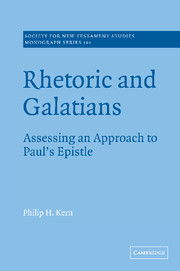Book contents
- Frontmatter
- Contents
- Preface
- List of abbreviations
- 1 Introduction
- 2 Towards a definition of rhetoric
- 3 Methods of rhetorical analysis and Galatians
- 4 Rhetorical structure and Galatians
- 5 Rhetorical species and Galatians
- 6 The language of Paul's letters: 1. As evaluated by early Christian writers
- 7 The language of Paul's letters: 2. The contribution of modern studies
- 8 Conclusions
- Select bibliography
- Index of subjects
- Index of modern authors
- Society for New Testament Studies
6 - The language of Paul's letters: 1. As evaluated by early Christian writers
Published online by Cambridge University Press: 22 September 2009
- Frontmatter
- Contents
- Preface
- List of abbreviations
- 1 Introduction
- 2 Towards a definition of rhetoric
- 3 Methods of rhetorical analysis and Galatians
- 4 Rhetorical structure and Galatians
- 5 Rhetorical species and Galatians
- 6 The language of Paul's letters: 1. As evaluated by early Christian writers
- 7 The language of Paul's letters: 2. The contribution of modern studies
- 8 Conclusions
- Select bibliography
- Index of subjects
- Index of modern authors
- Society for New Testament Studies
Summary
At least since Celsus put down his pen there have been only two possibilities: either Paul wrote badly in the classical style, or he chose another mode of expression altogether. If he chose another, many would still think that his words lack any literary quality – for there was, at least for Celsus, no other standard. And by classical we mean the polished pieces that have come down to us from the great Greek writers of literature. Those who compared Paul to these authors found his style wanting. But is this the proper standard?
In order to assess Paul's style in such a way as to shed light on the relationship between Galatians and classical rhetoric, it is necessary to evaluate the level of the language he used. We will attempt to satisfy this need by travelling two distinct pathways. In this chapter, we will consider the attitude of those closer than we are to Paul in time and in manner of education. They have much to say concerning Pauline style, sophistication and eloquence (or lack of each), all of them informed by their education and mastery of Graeco-Roman rhetoric. In the next chapter we will consider what, if anything, can be gathered from the various data which constitute our picture of Paul's background.
- Type
- Chapter
- Information
- Rhetoric and GalatiansAssessing an Approach to Paul's Epistle, pp. 167 - 203Publisher: Cambridge University PressPrint publication year: 1998



